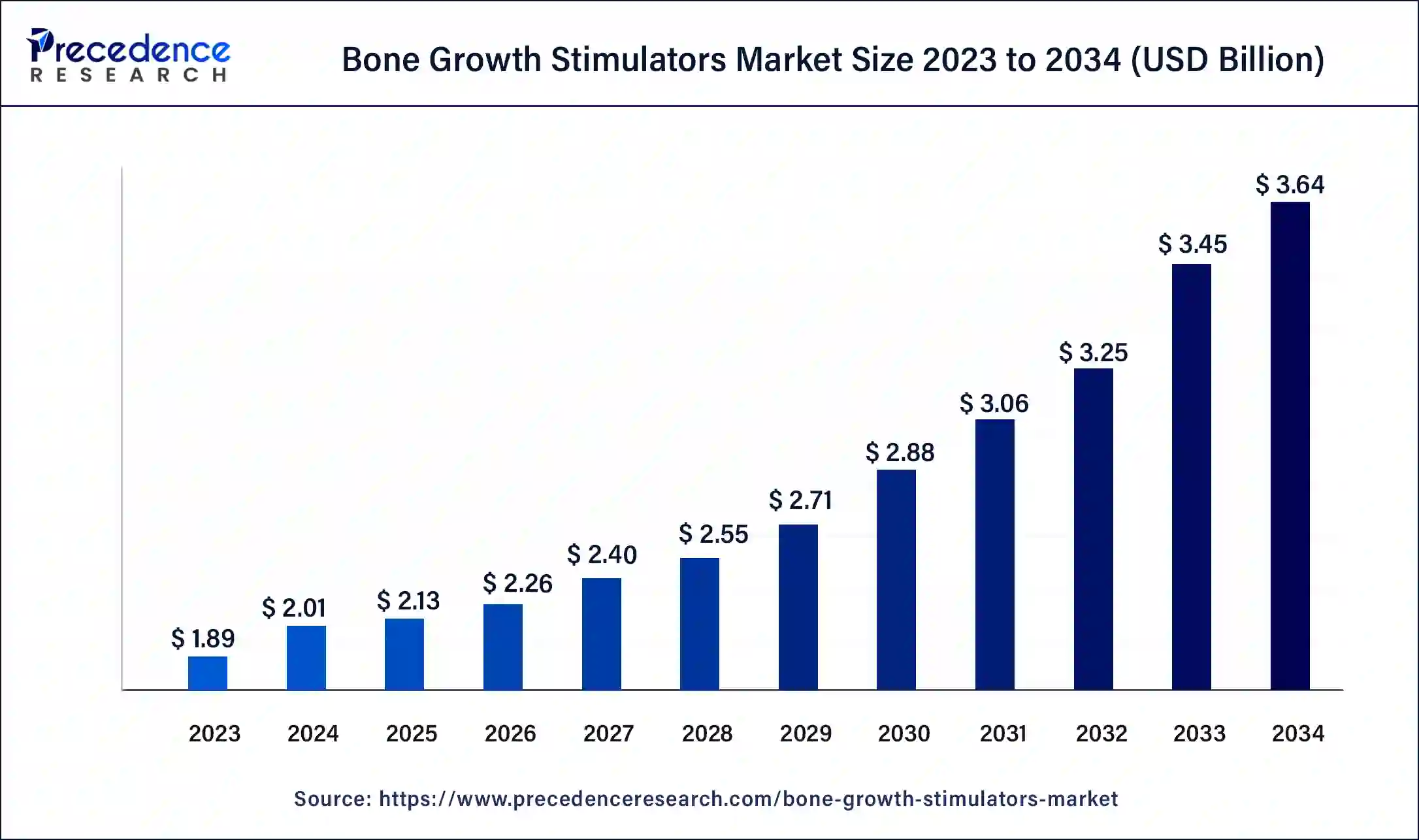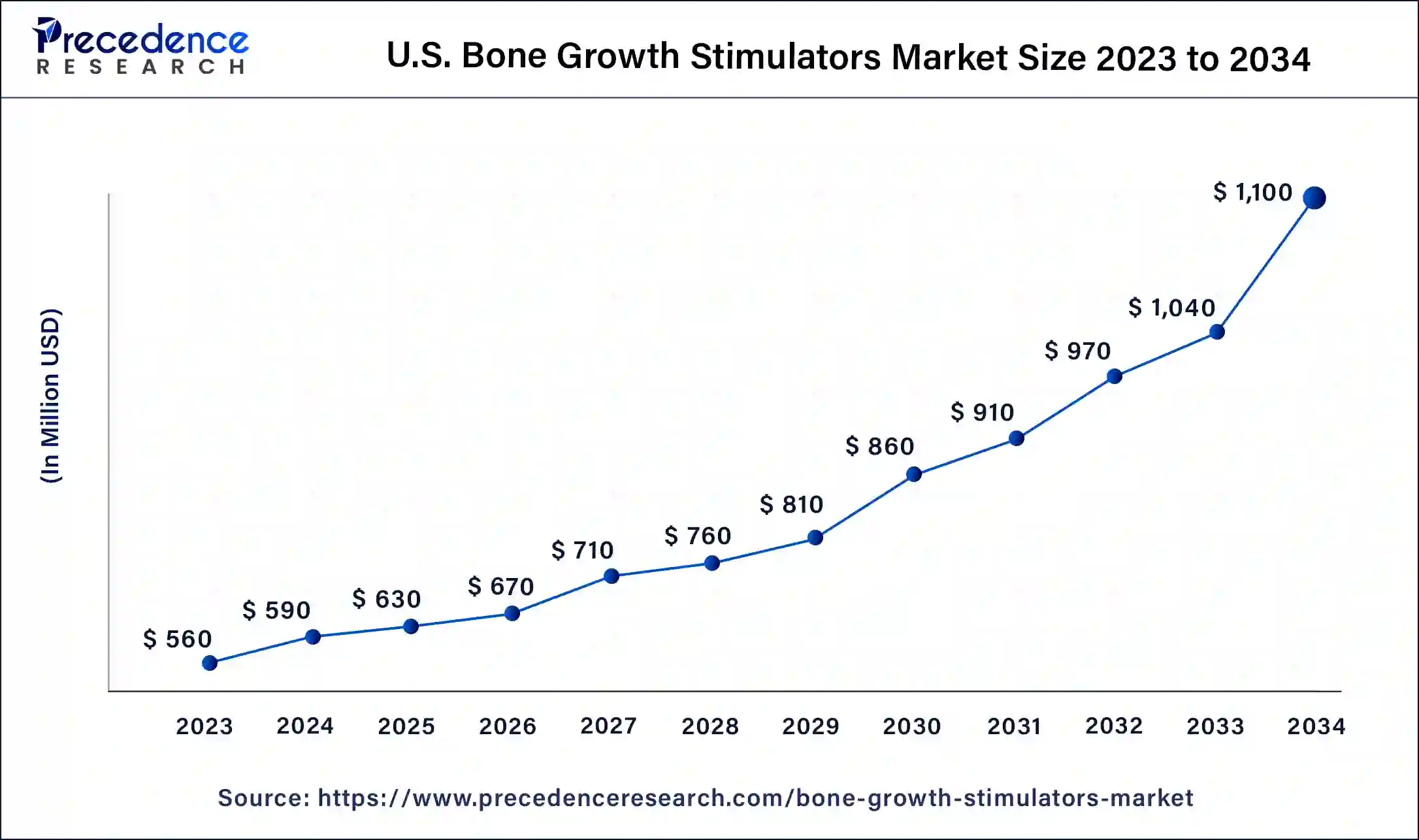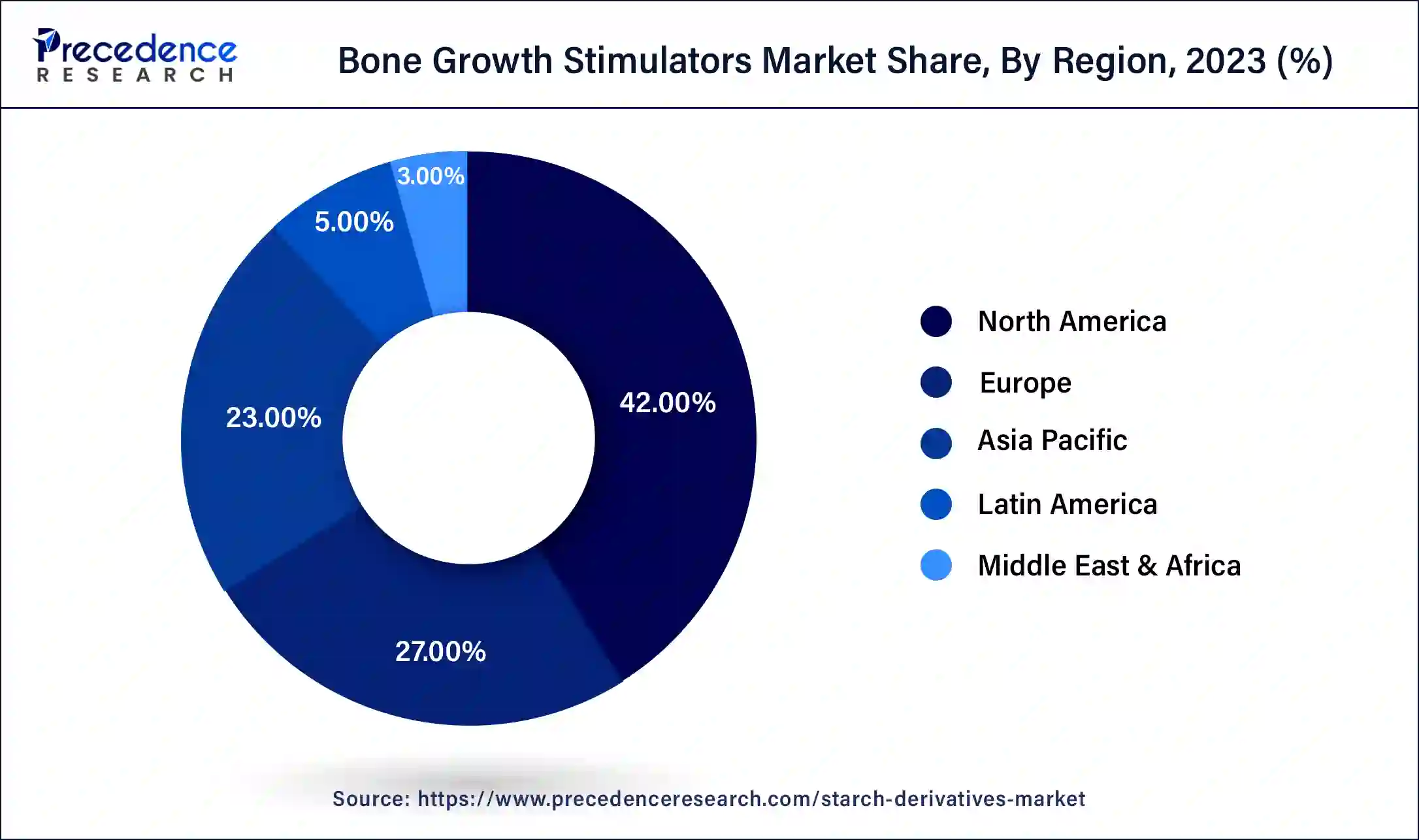March 2025
Bone Growth Stimulators Market (By Product: Bone Growth Stimulation Devices, Bone Morphogenetic Proteins, Platelet-Derived Growth Factor; By Application: Spinal Fusion, Maxillofacial & Dental, Non-union & union bone fractures, Others; By End User: Hospitals, Homecare, Others) - Global Industry Analysis, Size, Share, Growth, Trends, Regional Outlook, and Forecast 2024-2034
The global bone growth stimulators market size was USD 1.89 billion in 2023, accounted for USD 2.01 billion in 2024, and is expected to reach around USD 3.64 billion by 2034, expanding at a CAGR of 6.13% from 2024 to 2034.

The U.S. bone growth stimulators market size was estimated at USD 560 million in 2023 and is predicted to be worth around USD 1100 million by 2034, at a CAGR of 6.43% from 2024 to 2034.

The highest market share and dominant position in the bone growth stimulators industry belongs to North America. The main factors promoting regional dominance include rising healthcare costs, rising prevalence, and rates of related bone illnesses requiring the administration of bone growth stimulators. Strong procedure volumes for orthopedic problems will also considerably contribute to the large shares of this region. The growing knowledge of current therapies and technologies among medical professionals and patients are rising the market share of bone growth stimulators. The increasing prevalence of spinal problems, an ageing population, and increased population exposure to key risk factors are all factors that are fueling the expansion of the North American bone growth stimulator market.
The market in Europe is anticipated to have significant market growth throughout the observation period. Along with the high amount of procedures performed there for various sorts of orthopedic diseases, strong and emerging businesses like Bloventus is anticipated to contribute to the region's supremacy. increasing number of trauma occurrences and injuries, increasing number of spinal and orthopedic surgeries. Due of the rising demand for these instruments, bone morphogenetic proteins and platelet-rich plasma products, the market is anticipated to rise.
During the projection period, it is anticipated that the industry in Asia Pacific will grow profitably. The growing prevalence of bone ailments in the area has led to profitable development. The large pool of potential customers and the market's low penetration are anticipated to present profitable expansion prospects for bone stimulator firms to boost regional growth.

Bone stimulators are gadgets that serve as a source of continuous current. Usually, they have one anode and one or more cathodes. In order to promote bone formation surrounding its cathode or cathodes, the gadget is made to generate an electric current. Non-unions, or broken bones that don't mend, are frequently treated using bone stimulators. When there is insufficient stability, blood flow, or both, non-unions may happen. Non-unions can also be brought on by infections, especially after surgery. To promote healing, a bone stimulator sends pulsed electromagnetic pulses or ultrasonic waves to the nonunion site. The benefits associated with the bone growth stimulators are the factors responsible for the growth of the market across globe.
A fracture is the most severe issue brought on by bone disease, especially osteopenia, and may have been the patient's first obvious symptom of the illness. Women are more vulnerable to fractures than males, and the risk rises with age. For all ethnic groups, the risk of fractures and sickness increases as people live longer. However, it is anticipated that as the population ages, conditions like osteoporosis and low bone mineral density would become more common.
The benefits these procedures have over conventional treatment methods, the demand for minimally invasive procedures has increased significantly. The main benefits of minimally invasive operations are fewer postoperative problems, a shorter hospital stay, less pain, smaller and more cosmetic incisions, a lower risk of infection, less postoperative care, and a quicker recovery. Modern technologies are used in minimally invasive procedures to identify and treat diseases like cancer. These treatments are utilized as an efficient method for removing cancerous tumors and lymph nodes without leaving scars.
| Report Coverage | Details |
| Market Size in 2023 | USD 1.89 Billion |
| Market Size in 2024 | USD 2.01 Billion |
| Market Size by 2034 | USD 3.64 Billion |
| Growth Rate from 2024 to 2034 | CAGR of 6.213% |
| Base Year | 2023 |
| Forecast Period | 2024 to 2034 |
| Segments Covered | Product, Application, End User, and Region |
| Regions Covered | North America, Europe, Asia-Pacific, Latin America, and Middle East & Africa |
Depending upon the product type, the bone growth stimulation devices segment accounted largest market share in 2023. The attention of specialists on creating new, non-invasive stimulation gadgets has increased demand for these items even more. The market for bone growth stimulators will rise as non-surgical treatment options become more popular and nonunion fractures become more common. People are more concerned about the health and they have a fear of getting operated thus, the non-surgical options are used in many cases due to its reliability.
Over the course of the forecast period, the platelet-derived growth factor segment is anticipated to experience a relatively higher growth rate. The frequency of fractures and trauma cases has increased, which has increased demand for these products. As a result, producers work tirelessly to create and promote PDGF-based medicines around the world, supporting the market's expansion.
Periodic bone remodeling and bone regeneration, both closely regulated processes involving bone creation and bone resorption, are essential for maintaining bone health. Bone morphogenetic proteins (BMPs) are well-documented key regulators of osteoblast development and bone formation.
During the projected period, the spinal fusion segment is anticipated to be the largest in the bone growth stimulators market. High segment shares are primarily caused by the huge patient populations undergoing spinal fusion operations all over the world. Additionally, the expensive nature of the process and the rising number of procedures are the main drivers of the segment's lucrative market shares over the course of the analysis time frame. A surgical treatment called spinal fusion is done to treat issues with the little spine bones, vertebrae. Essentially, it is a welding process. The fundamental concept is to join two or more vertebrae together so that they recover into a single, solid bone. This is carried out to stop uncomfortable motion or to provide the spine some stability. Following cervical (neck) or lumbar (low back) spine surgery, a bone growth stimulator is an additional device worn. After a spinal fusion, BGS may be used to aid with the fusing of the spinal bones.
On the other hand, the sector for non-union and union bone fractures is anticipated to expand at a high rate during the projection period. High growth is mainly caused by the rise in fracture and trauma cases around the world. Increased fracture cases are being caused by an increase in sports injuries and traffic accidents, which is accelerating segmental growth. Some young athletes may have an advantage over their seniors in competitive sports. Young children's physical and emotional well-being, sense of self, and interpersonal skills can all be enhanced by athletics when enjoyment, teamwork, and good sportsmanship are the primary objectives. However, increasing muscles, tendons, and bones must also be taken into account by young sportsmen. Sports-related injuries can occur.
During the projected period, the hospital segment is leading in bone growth stimulators market. In hospitals, items for bone development stimulation are utilized for a variety of procedures, such as spine surgeries, oral and maxillofacial surgeries, dental procedures, and bone fractures. The key factors propelling the growth of the bone growth stimulator market for hospitals are the advantages of bone growth stimulation products over their competitors, increasing prevalence of spinal disorders, increasing procedural volumes of spinal fusion surgeries, the rising patient population, and growing awareness of bone growth stimulation products.
For a variety of reasons, the specialty clinics market is predicted to have the greatest CAGR. The development of specialist clinics, where the focus of care is on particular medical specialties like orthopedics, is one of the most significant market trends in developed markets. Due to the need for specialist care in the diagnosis and treatment of bone fractures, the segment is predicted to rise throughout the forecast period.
Recent Developments
Segments covered in the report
By Product
By Application
By End User
By Geography
For inquiries regarding discounts, bulk purchases, or customization requests, please contact us at sales@precedenceresearch.com
No cookie-cutter, only authentic analysis – take the 1st step to become a Precedence Research client
March 2025
August 2024
February 2025
February 2025